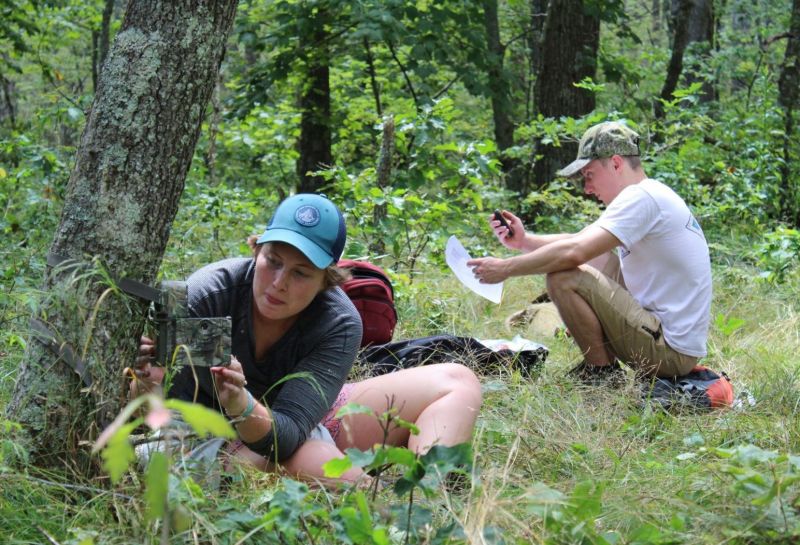
Six students, carrying backpacks, trail cameras, a GPS and other gear, made their way through the woods on a humid day last August. Their task: set up cameras to collect images and other data on medium to large animals in the forest near Pembroke, Virginia.
Armed with topographical maps and GPS coordinates, their first step was to find locations for setting up each camera trap. The students started out along the War Spur hiking trail, but they soon veered off into the woods.
Once they found the right spot, they used a machete to cut down long grass so it would not get in the way of the camera traps, which they then fastened to trees with straps. For the next nine days, the cameras, which are motion activated, would be taking snapshots of wildlife that passed within range.
This adventure was all in a day’s work for 50 students from the College of Natural Resources and Environment participating in a 10-day field experience at Mountain Lake Biological Station. The fieldwork was their chance to put to the test the skills and knowledge acquired during the spring semester as part of the Wildlife Field Techniques course.
The course, led by Professor Marcella Kelly of the Department of Fish and Wildlife Conservation, is a requirement for wildlife conservation majors. Its main purpose is to show students how to study various animals, including employing proper capture and handling techniques, in a humane fashion and how to function as biologists in the field.
“This experience is close to the real thing they will experience if they go on to work wildlife field jobs or go to grad school and conduct research on wildlife,” Kelly said. “This major is unusual in that it includes both academic ability and practical field skills. It is like nothing else most students have experienced.”
For the entire 10-day experience, students stayed in lodges at the station, with very limited internet access. Field activities included everything from bat detecting to vegetation data collection. Students were responsible for setting up camera traps and small mammal trapping grids, managing bird point counts and collecting and interpreting data. On some days, students worked from 5:30 a.m. to 2:30 a.m., depending on the projects.
The course also included a capture workshop — led by experts from the U.S. Department of Agriculture, the Conservation Management Institute at Virginia Tech and the Virginia Department of Game and Inland Fisheries — in which students learned about foothold traps, drop nets, dart guns and chemical immobilization.
Besides the field work, students worked on more traditional assignments and completed group projects, gave final presentations, wrote a final paper and took quizzes and a final exam.
“It’s hard being in the classroom all the time as a wildlife major, so getting out here and being able to experience nature and setting up camera traps and getting to do all the things we learn about is pretty awesome,” said Kailyn Kampert, a senior majoring in wildlife conservation.
Jamie Craven, another senior wildlife conservation major, said she learned that field work is hard work: “It opened my eyes to what it would be like if I were to work in a wildlife field setting.”
— Written by Haley Cummings, University Relations intern

